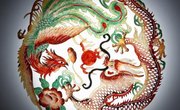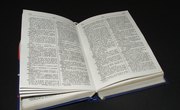Originally, a coat of arms was used to differentiate between the soldiers of competing armies. For the last 400 years, it has come to mark families, especially nobility. In the 17th century, some private businesses were recognized by their heraldic symbols. In the United States today, they are most frequently used by universities.
Figure out what kind of coat of arms your specimen is. There are sharp differences between family and national heraldry. Families often have a simple shield. Nations use a more complicated design, with animals, arrows, flags, and other symbols. You can start by flipping through Arthur Charles Fox-Davies's "A Complete Guide to Heraldry," to get a sense of the variety.
Consider how the coat of arms might have been influenced by national legislation. Since some countries strictly regulated heraldic composition, you can often identify the coats as originating in England or France. To explore national tendencies in design, consult books that have compiled heraldic information within countries, such as Michael C. O'Laughlin's "Irish Book of Arms: Genealogy and Heraldry."
Identify the iconography on the coat of arms. This iconography is usually linked to the owner in literature or art. It might involve a form of wordplay, such as the similarity between a family’s name and a word in the language. Alternatively, it might allude to a great accomplishment in the nation’s history. But there are other clues, too. For example, the Brown University coat of arms represents the beliefs and principles of its founders. The university was founded as a Baptist answer to the founding of Harvard by Puritans and the founding of Princeton by Presbyterians. Within the coat of arms a shield is bisected by a crucifix, with open books sitting in the four quadrants. The crucifix is a particularly important symbol in Baptist iconography, and it is important to note that in no other Ivy League coat of arms is it as prominent. Because the coat has no royalist imagery and no allusion to British rule, you can reasonably assume that it was founded late in the 18th century, maybe around the American Revolution. The religious imagery suggests it was founded well before most universities became less sectarian in the 19th century.
Search for any mottos or expressions that might indicate more specifics. Many American university mottos are rendered in Latin, since many founders were familiar with Latin and thought it more cultured and scholarly than English.
Related Articles
References
- College of Arms
- Complete Guide to Heraldry; Arthur Charles Fox-Davies, 2000.
- Irish Book of Arms; Michael C. O'Laughlin, 2001.
Writer Bio
John Yargo is a sports writer, living in Orlando, Fla. His work regularly appears in the "Jackson Free Press," and he has published articles on theater, fiction and art history. He has also received a master's degree in English.










